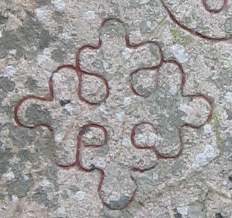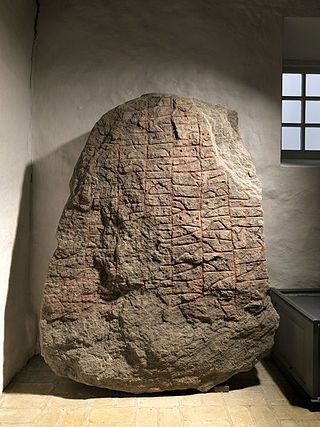The Funbo runestones constitute a group of four runestones originally from Funbo in the province of Uppland, Sweden, which were raised by members of the same family during the eleventh century.
The Runestones of Högby are runestones located in the village of Högby in Östergötland, Sweden, but the name Högby runestone usually refers to the notable Ög 81. It is famous for its eloquent epitaph in fornyrðislag for all the five sons of a man. The runestone was found when the church was demolished in 1874. Fragments of some other runestones were found as well. The Rundata project dates them to the late 10th century.

The Färentuna runestones are 11th century runestones labelled U 20, U 21, and U 22 in the Rundata catalog that are located in Färentuna, Uppland, Sweden. Runestones U 20 and U 21 were registered separately although they come from the same original runestone and consequently are called U 20/21. The runestone U 20/U 21 is probably most interesting as it, together with the Hillersjö stone and the Snottsta and Vreta stones, tells the story of the family of Gerlög and Inga. All of the Färentuna runestones are inscribed in the younger futhark.

The Snottsta and Vreta stones are individual runestones known as U 329, U 330, U 331 and U 332. They are found on the homesteads of Snottsta and Vreta, and they tell in Old Norse with the younger futhark about the family story of Gerlög and Inga in 11th century Uppland, Sweden, together with the Hillersjö stone and the runestone U 20/21.

The runestones known as U 101 is located in Sollentuna, and U 143 and U 147 are located in Täby; all three are in Uppland, Sweden. They are all in the style Pr4 and thus dated to the period 1060-1100 during which they were carved in connection with the construction of a road from Hagby to Ed at Edsviken. They belong to a group of c. 20 runestones called the Jarlabanke Runestones that are connected to the local chieftain Jarlabanke and his clan. Together with the Broby bro Runestones and the Hargs bro runic inscriptions these particular runestones, however, centre on the female matriarch of the clan called Estrid, who was the grandmother of Jarlabanke.

The Jarlabanke Runestones is the name of about 20 runestones written in Old Norse with the Younger Futhark rune script in the 11th century, in Uppland, Sweden.
The Ingvar runestones is the name of around 26 Varangian Runestones that were raised in commemoration of those who died in the Swedish Viking expedition to the Caspian Sea of Ingvar the Far-Travelled.

The Orkesta Runestones are a set of 11th-century runestones engraved in Old Norse with the Younger Futhark alphabet that are located at the church of Orkesta, northeast of Stockholm in Sweden.

The Lingsberg Runestones are two 11th-century runestones, listed as U 240 and U 241 in the Rundata catalog, and one fragment, U 242, that are engraved in Old Norse using the younger futhark. They are at the Lingsberg farm about 2 kilometres (1.2 mi) east of Vallentuna, which is about 24 kilometres (15 mi) north of the center of Stockholm, Stockholm County, Sweden, which was part of the former province of Uppland.

The Hagby Runestones are four runestones that are raised on the courtyard of the farm Hagby in Uppland, Sweden. They are inscribed in Old Norse using the Younger Futhark and they date to the 11th century. Three of the runestones are raised in memory of Varangians who died somewhere in the East, probably in Kievan Rus'.
The Greece runestones are about 30 runestones containing information related to voyages made by Norsemen to the Byzantine Empire. They were made during the Viking Age until about 1100 and were engraved in the Old Norse language with Scandinavian runes. All the stones have been found in modern-day Sweden, the majority in Uppland and Södermanland. Most were inscribed in memory of members of the Varangian Guard who never returned home, but a few inscriptions mention men who returned with wealth, and a boulder in Ed was engraved on the orders of a former officer of the Guard.

The Risbyle Runestones are two runestones found near the western shore of Lake Vallentunasjön in Uppland, Sweden, dating from the Viking Age.

The Varangian Runestones are runestones in Scandinavia that mention voyages to the East or the Eastern route, or to more specific eastern locations such as Garðaríki in Eastern Europe.
The Viking runestones are runestones that mention Scandinavians who participated in Viking expeditions. This article treats the runestone that refer to people who took part in voyages abroad, in western Europe, and stones that mention men who were Viking warriors and/or died while travelling in the West. However, it is likely that all of them do not mention men who took part in pillaging. The inscriptions were all engraved in Old Norse with the Younger Futhark. The runestones are unevenly distributed in Scandinavia: Denmark has 250 runestones, Norway has 50 while Iceland has none. Sweden has as many as between 1,700 and 2,500 depending on definition. The Swedish district of Uppland has the highest concentration with as many as 1,196 inscriptions in stone, whereas Södermanland is second with 391.
The Baltic area runestones are Viking runestones in memory of men who took part in peaceful or warlike expeditions across the Baltic Sea, where Finland and the Baltic states are presently located.

Østermarie is a village on the Danish island of Bornholm, 8 km (5.0 mi) west of Svaneke. Founded ca. 1880, its old church, now a ruin, dates back to the 12th century. The population as of 1 January 2023 is 482.

The Kyrkogården Runestones are three Viking Age memorial runestones located at the cemetery of St. Mary's Church in Sigtuna, Stockholm County, Sweden, in the historic province of Uppland. One of the runic inscriptions documents the existence of a Viking Age mercantile guild in Sweden.

The Ålum Runestones are four Viking Age memorial runestones which are located at the church in Ålum, which is 9 km west of Randers, Denmark. One of the stones refers to a man with the title drengr and two of the other stones were raised by the same family.

The Sønder Vinge stone 2 or DR 83 is a Viking Age runestone engraved in Old Norse with the Younger Futhark runic alphabet. The stone is in granite and was discovered in 1866 as a corner stone of Sønder Vinge Church, positioned with the runic inscription outwards. It is presently located in the porch of the church. It is probably from the period 970-1020 due to runic and linguistic features. It is 180 cm tall, 132 cm wide and 35 cm thick. Parts of the runic inscription have eroded which makes some runes hard to read. The style of the runestone is the runestone style RAK.

The Fuglie stone 1 or DR 259 is a Viking Age runestone engraved in Old Norse with the Younger Futhark runic alphabet. It was first mentioned by Skonvig and it is still located in its original location on a Nordic Bronze Age mound next to the church of Fuglie, Skåne, Sweden. There are many local legends and traditions about the stone. The stone is 105 cm tall, 63 cm wide, and 33 cm thick. The stone is dated to the period 970–1020, and the style of the runestone was the runestone style RAK.














